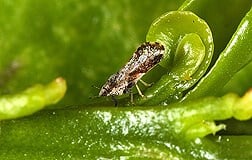An acoustic trap developed by U.S. Department of Agriculture (USDA) scientists may offer an environmentally friendly way to control Asian citrus psyllids, gnat-sized insect pests that transmit Huanglongbing, a devastating citrus disease also known as “citrus greening.”
Infected citrus trees cannot be cured and often die within several years. Until such time, they may bear green, misshapen fruit with acidic-tasting juice, making the fruit unmarketable.
Concern over the cost and long-term environmental impact of using insecticides to control psyllid populations in citrus-growing states like Florida has prompted an intensive search for alternative measures, notes Richard Mankin, an entomologist with USDA’s Agricultural Research Service (ARS) in Gainesville, Florida.
To that end, Mankin designed an acoustic trap based on his experience investigating how insect pests use their sense of smell, sight or hearing to locate food and mates. Together with University of Florida graduate students, Mankin decoded the psyllid’s signaling patterns and recreated them with electronics including a buzzer and a microphone.
Many of the traps now used to control crop-damaging insects use chemical attractants, or “pheromones.” Low doses of pheromones can lure pests into traps; high doses can saturate the air so thickly that pests fail to meet and mate. The acoustic trap is different: It mimics the wing-buzzing vibrations male and female psyllids use instead of pheromones to locate and court one another in citrus trees.
In citrus trees, a male psyllid normally crawls to the female after the female responds to the male’s wing-buzzing vibrations. In laboratory studies, however, the trap is also listening to this vibration, and it responds a tenth of a second or two before the female with a fake signal, luring the males into a nearby sticky trap.
Mankin’s team is refining the trap for outdoor testing this summer. Read more about this research in the May 2016 issue ofAgResearch magazine.
ARS is USDA’s principal intramural scientific research agency.

